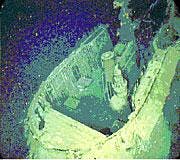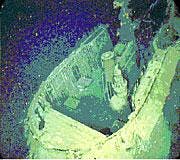In the process of exploring for oil and natural gas under the Earth's waters, oil companies conducting surveys occasionally make some other interesting discoveries, such as sunken aircraft, ships, and U-boats (OGJ, Aug. 20, 2001, p. 19).
In the Gulf of Mexico, for example, 56 ships destroyed during World War II lie on the seabed, one of the great concentrations of commercial war casualties in the world.
Seven such shipwrecks in the northern gulf—three tankers, two freighters, a German U-boat (see photo), and a steam yacht that sank accidentally—currently are the subject of a pilot study to determine the impact humans have on the deepwater marine environment, the impact deepwater marine conditions may have on manmade vessels, and the artificial-reef effect of manmade structures in deep water.
Decommissioned oil and gas platforms scuttled onsite and now serving as artificial reefs in shallow water are already known to be beneficial to sea life, but additional information is needed to determine their long-term effects in the study also could determine if such rigs-to-reefs programs can be expanded to deepwater areas. Such an expansion could offer huge potential cost savings to offshore operators—not to mention a boon to the gulf fishing industry.
The sponsoring study group—US Minerals Management Service, in collaboration with 14 federal agencies and other scientific and technical partners—is performing archaeological, historical, and biological analyses at the wreck sites. The selected vessels all sank in 1942 or early 1943 within months of each other, so they have been in the water for about the same amount of time but carried different cargoes and sank in different water depths—280-6,450 ft, making each of these site variables unique.
The $1.2 million study, to determine the effect of manmade vessels on deepwater marine environment and the converse effect of the environment on those vessels, began July 29 with the departure of the research and exploration vessel HOS Dominator from Port Fourchon, La. During the 18-day project, while scientists work around the clock in dual shifts, the ship will visit and acquire specimens and take samples from six sites. One site will combine the Robert E. Lee freighter sunk by the U-166 German submarine and the nearby U-boat, itself sunk by the freighter's Naval Patrol escort, as if in a giant deadly chess game.
null
The study
MMS, in partnership with the National Oceanic and Atmospheric Administration's Office of Ocean Exploration (OOE) under the auspices of the National Oceanographic Partnership (NOP), selected as prime contractor for the expedition Lafayette, La.-based C&C Technologies Inc., which was responsible for the discovery of many of the shipwrecks. MMS is contributing $350,000 toward research costs, and OOE is funding ship time; Sonsub Inc., Houston, is providing the Triton XL remotely operated vehicle and personnel for both the ship and ROV.
In addition to C&C personnel and the crews of the ship and ROV, the international exploration team includes more than 22 specialists in the fields of biology, microbiology, marine invertebrates and vertebrates, marine archaeology, history, and videography. These scientists represent MMS, OOE, NOP, Droycon Bioconcepts, the PAST Foundation, the University of Alabama-Dauphin Island Sea Lab, University of Alaska-Fairbanks, University of West Florida, and Montana State University.
Benefits
In addition to the previously mentioned purpose, MMS said it wants to verify the vessels' identities and better understand the size of the fields expected around deepwater wrecks and their state of preservation and future research potential, in order to make management decisions concerning disturbance avoidance "and the eligibility of these properties for the National Register [of historical places]."
A video crew is creating a documentary of the project, and material is updated online daily for the public at http://www.pastfoundation.org/DeepWrecks/ during the offshore expedition ending Aug. 19. The scientists, however, will continue to study and evaluate marine specimens, materials samples, and other acquired data for many months.
Stand-alone educational modules will be created on subjects such as marine life and underwater pressures for students in grades 6-12, as well as modules for journalism and English classes, thus expanding the cycle of discovery.

